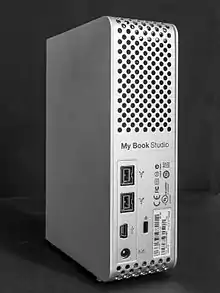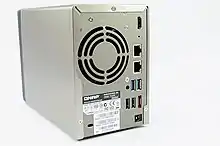Direct-attached storage
Direct-attached storage (DAS) is digital storage directly attached to the computer accessing it, as opposed to storage accessed over a computer network (i.e. network-attached storage). Examples of DAS include hard drives, solid-state drives, optical disc drives, and storage on external drives. The name "DAS" is a retronym to contrast with storage area network (SAN) and network-attached storage (NAS).


Features
A typical DAS system is made of a data storage device (for example enclosures holding a number of hard disk drives) connected directly to a computer through a host bus adapter (HBA). Between those two points there is no network device (like hub, switch, or router), and this is the main characteristic of DAS.
The main protocols used for DAS connections are ATA, SATA, eSATA,[1] NVMe, SCSI, SAS, USB, USB 3.0 and IEEE 1394.
Storage features of SAN, DAS, and NAS
Most functions found in modern storage do not depend on whether the storage is attached directly to servers (DAS), or via a network (SAN and NAS). In enterprise environments, direct-attached storage systems can utilize storage devices that have higher endurance in terms of data workload capability, along with scalability in the amount of capacity that storage arrays can achieve compared to NAS and other consumer-graded storage devices.[2]
Advantages and disadvantages
The key difference between DAS and NAS is that DAS storage is only directly accessible from the host to which the DAS is attached. A DAS does not incorporate any network hardware and related operating environment to provide a facility to share storage resources independently. The storage presented by a DAS to a connected host can of course be shared by that host. A SAN (storage area network) has more in common with a DAS than a NAS with the key difference being that DAS is a 1:1 relationship between storage and host whereas SAN is many to many.
DAS is also generally faster than NAS, with most networks being limited to 1Gbps, while USB 3.0, common on external drives, supports up to 5Gbps.[3]
See also
- Secondary storage device versus tertiary storage device or nearline storage — storage that remains attached versus storage that is attached or detached as needed
- RAID
- JBOD
- Storage area network
- Network-attached storage
References
Englander, I. (2014). The architecture of computer hardware, systems software, & networking: An information technology approach (5th ed.). Retrieved from https://online.vitalsource%5B%5D. com/#/books/9781118803127